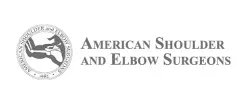Reverse shoulder replacement is a specific type of replacement that is designed for patients with rotator cuff tears that cannot be fixed and are causing substantial loss of arm strength and function. The main indication for this operation and pain and loss of function that severely interferes with a patient’s quality of life and has not responded to other treatments such as injections or physical therapy. Long standing rotator cuff tears can cause arthritis of the shoulder, a condition known as cuff tear arthropathy.
Small rotator cuff tears can often be successfully treated without surgery. However, as tears enlarge, they can result in inability to raise the arm above chest height. This may severely impact simple daily activities like eating, dressing and personal hygiene. The picture to the right demonstrates how this patient needs to fully raise her elbow to reach her mouth with her right arm due to inability to rotate the arm away. To compensate for lost function, the shoulder tries to adapt with motion of the shoulder blade on the chest wall but this can be a source of pain and fatigue. Long standing tears can cause atrophy of the rotator cuff muscle that becomes permanent when long standing.
Reverse shoulder replacement means the ball and socket and reversed. In a normal shoulder, the ball sits atop the humerus bone and the socket is part of the shoulder blade. A reverse shoulder replacement puts the ball where the socket is and a socket where the ball normally is. The ball is attached to the shoulder blade with several screws and a central post. The socket is attached to a stem that is inserted into the humerus bone. There are many different reverse implant designs on the market but each works by the same principle and has the same goal of relieving pain and improving overhead function.
Reverse shoulders accomplish this task by increasing the mechanical advantage of the deltoid muscle. By moving the center of rotation of the ball from inside the humerus bone to inside the shoulder blade, reverse shoulders double the distance between the deltoid muscle and the center of rotation of the joint. This doubles the work the deltoid can do. The geometry of the implant also reduces instability that can occur with cuff tears and gives the deltoid a stable fulcrum about which to rotate the arm.
Reverse shoulder replacements were first introduced into the US in 2004. Since them prosthesis design has improved substantially as engineers and surgeons have determined the potential complications and causes of failure with earlier designs. In the past 3 years, the frequency of use of reverse implants has surpassed conventional shoulder replacements and some surgeons feel that their durability will outlast standard shoulder implants. Once of the reasons for this rapid rise in their use is the widening indications and diagnoses for which they can provide a definitive solution.
The following are diagnoses that are commonly treated with reverse shoulder replacements
· Rotator cuff tear arthopathy
· Massive rotator cuff tears with severe shoulder weakness (pseudoparalysis)
· Severe fractures of the shoulder
· Shoulder osteoarthritis with considerable wear and erosion of the shoulder socket
· Primary osteoarthritis with poor rotator cuff tendon quality
· Inflammatory arthritis of the shoulder
· Post-traumatic arthritis of the shoulder where there may be altered anatomy from healing of a prior fracture
· Chronic dislocations with damage to the cuff and humeral head.
Perhaps one of the more common scenarios where reverse shoulder replacements have made inroads is their use in osteoarthritis in patients in their late 70s and early 80s and in patients with considerable socket erosion from the wear process. Experience has shown that when standard shoulder replacements are used in this setting, results can be inferior, and complication rates and failure rates can be higher.
With 15 years of clinical use, expert shoulder surgeons have gained a better understanding for who is an appropriate candidate for reverse shoulder replacement, as well as how to avoid common complications. Over time, the safety and efficacy of these operations has improved however there are unique complications such as stress fractures and dislocations that can occur during the recovery period and require careful adherence to the recovery program.
Dr. Parsons performed the first reverse shoulder replacement in New Hampshire in 2004 and has performed hundreds of these operations over the years. He has published clinical research on this topic and his research has been accepted for presentation at both national and international meetings. He is also a designer of the GPS shoulder navigation technology which has proven a global success in helping surgeons optimize implant positioning during surgery.


















